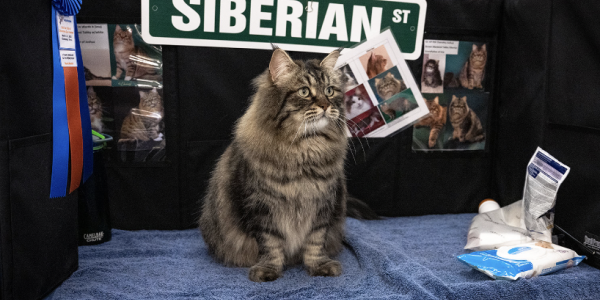In his new book on cat biology, biologist Jonathan Losos takes readers from the Fertile Crescent to modern-day cat shows to unravel the mysteries of feline evolution.

Somewhere between 4,000 and 10,000 years ago, wildcats in the Fertile Crescent made a bold move. Humans had started to raise and store grains to feed their growing villages, and those piles of grain attracted mice. The bravest of the wildcats — long-legged cats with short, sand-colored coats — lurked around huts and grain bins looking for mice, a decision that set off a cat-human partnership that has spanned millennia. “We didn’t really seek out cats,” said Jonathan Losos, the William H. Danforth Distinguished University Professor and director of the Living Earth Collaborative. “They sought out us.”
Losos explores the origins and biology of domestic cats in his new book “The Cat’s Meow: How Cats Evolved from the Savanna to Your Sofa.” The book, aimed at cat enthusiasts who want a deeper understanding of their feline companions, takes readers from prehistoric encounters in the Middle East to a modern-day cat show in Kansas.
Losos, who teaches an upper-level WashU biology course called “The Science of Cats,” understands the appeal of felines. He is, after all, the owner of four: Archie, Jane, Winston, and Nelson. But his book goes far beyond a mere appreciation of his four-legged housemates. He uses cats as vessels for deep thoughts about biodiversity, evolution, and ecology, all while giving readers a richer understanding of felines, including the subtle differences between domestic cats and their wild ancestors.
While domestic cats have smaller brains than wildcats, Losos cautioned that this doesn’t mean a wildcat on the savanna is significantly smarter than the tabby on your lap. “Cats didn’t become dumb,” Losos said. “Through domestication, they seem to have lost a part of the brain that deals with alertness and nervousness. Domestic animals just don’t need to be on edge all the time.”
Domestic cats span a wide spectrum of colors, hair types, and personalities. Losos’ book describes some true oddities of the cat world, including the curly haired Devon rex, the ragdoll (named for its penchant for going limp when picked up), and the Maine coon (a relative giant that can reach nearly 30 pounds).
But even with that diversity, cats are practically monolithic compared to dogs, which range from dachshunds to wolfhounds and everything in between. Genetic studies, including work conducted at WashU’s McDonnell Genome Institute, confirm that the DNA differences between wild and domestic cats are relatively minor compared to the gulf between domestic dogs and their wolf predecessors.
So, why are cats all so catlike? Losos writes that cats were domesticated 10,000 or more years after dogs, so humans have had much less time to tinker with feline breeding. Also, many dogs have been bred for specific tasks — dachshunds, for example, are an ideal size and shape to hunt in rabbit burrows — while cats have never been especially task-oriented. There may be a more practical reason why there’s no housecat version of a Great Dane. “Maybe breeders just had the good sense to not create a 50-pound cat,” Losos said.
Still, Losos said breeders haven’t always made the best choices. His book describes the “severe skull and brain abnormalities” of flat-faced Persian cats. The look may be stylish or cute to some, but the animals paid a price. “Persians are widely regarded as not the sharpest knives in the drawer and have been observed running into objects and falling off windowsills,” he wrote.


The four cats in the Losos household are mixed lot who happen to have varied feelings about each other. Jane and Winston are siblings with a close bond. Nelson, it is said, can be a bit of a bully to the other two, perhaps emboldened by the fact that he is clearly Losos’ favorite (a point the biologist denies — “I love them all equally,” he said).
While cats have a reputation for being solitary, uncaring, and aloof, Losos said they can have complex personalities and social lives. The book describes how feral cats often gather into colonies that can in many ways resemble prides of lions. Closely related females will groom each other, lie on top of each other, and even nurse each other’s kittens.
Cats can be very affectionate to humans, too. Losos sees that in his own house. Nelson will curl up on his lap and occasionally attempt to assist Losos at the computer with a paw to his mousepad. He’ll also purr at the mere sound of his leash and harness being pulled from the closet, a sign that he’s about to go outside with his favorite human. The walk never gets very far, though. Once outside, Nelson mainly wants to sniff the ground and scratch an occasional tree. It’s another reminder that cats will be cats. And for feline fans like Losos, that’s all they need to be.





